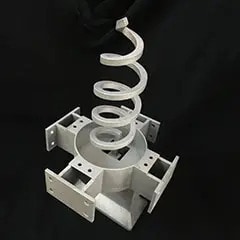Additive Manufacturing is reaching outer space. With increased effectiveness and maturity of space programs all over the world, leaders in the space community, are innovating, developing and iterating on multiple frontiers that lead to faster and cheaper deployment of payloads . The Wipro 3D has re-engineered, developed, and proved out flight-ready components in short “re-design to realize” lifecycles to meet such requirements.
Private space enterprises, state-run-space organizations, and other members of the space industrial ecosystems are replacing existing and conventional geometries, with designs using the freedom of design that Additive Manufacturing brings, leading to significant impact on performance.
About the Project
Components such as antennae, wave guides, brackets, thrusters, main oxidizer valves, combustion chamber liners, and propellant injectors, are either in the prototyping stage or are actually flying. The ‘Antenna Integrated Helix Feed’ is part of a transmitter system which is used to amplify RF signals. Typically, helical geometries are used to carry RF waves and an electron beam is passed axially through the helical structure.
The RF wave and the electron beam converge at the tip of the helical structure resulting in an amplified RF wave.
In general, helical geometries are difficult to realize without high failure or high wastage in conventional manufacturing techniques. Even with the freedom of Additive Manufacturing, helical structures are challenging. Wipro 3D has successfully realized the ‘Antenna Integrated Helix Feed’ using its proprietary build know-how for powder bed processes. The component is currently under testing at a Satellite Communications laboratory.
Application of Additive Manufacturing and Value Addition
For certain geometries, a different approach to key build parameters was developed to ensure shrinkage and dimensional tolerances were achieved as planned. Surface finish as built was improved through the same set of changed parameters.
Build Orientation, other build strategies were used to develop this complex structure with an aim to minimize net shaping operations, owing to the delicate geometry and features of the component
With the process package established, the customer now has the ability to make design alterations to improve the functional performance, with very short “Redesign-to-realize” cycle time. The Helix was realized in under 6 weeks including developmental iterations.
Subscribe to AM Chronicle Newsletter to stay connected: https://bit.ly/3fBZ1mP
Follow us on LinkedIn: https://bit.ly/3IjhrFq
Visit for more interesting content on additive manufacturing: https://amchronicle.com


